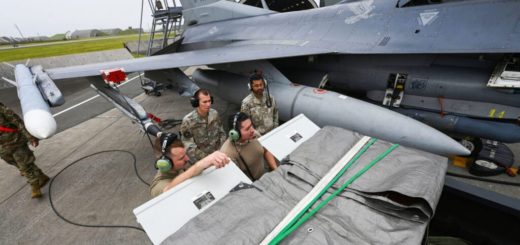Pakistan deploys its JF-17 Block III equipped with Chinese PL-15E missiles as tensions rise with India

{loadposition bannertop}
{loadposition sidebarpub}
In a context marked by escalating tensions between India and Pakistan following the deadly terrorist attack in Pahalgam, the Pakistan Air Force (PAF) released, on April 26, 2025, images showing its JF-17 Block III fighters equipped with very long-range PL-15 air-to-air missiles, as reported by @OSPSF on X. Widely circulated on social media, this announcement appears as a demonstration of Pakistan’s rapid efforts to strengthen its air capabilities. However, a detailed analysis suggests that it may be more of a strategic communication move than a significant operational breakthrough.
Follow Army Recognition on Google News at this link
The release of images showing the JF-17 Block III armed with PL-15E missiles comes at a time of heightened regional tension (Picture source: X Channel @OSPSF)
The missiles presented are most likely PL-15E models, the export version of the PL-15, supplied by China under a $1.525 billion contract that included the delivery of 20 J-10CE fighters, 10 spare WS-10B engines, and 240 PL-15E missiles. Unlike the version operated by the Chinese Air Force, capable of engaging targets at distances between 200 and 300 kilometers, the PL-15E is limited to a range of approximately 145 kilometers. This reduction directly impacts the overall effectiveness of the JF-17 Block III despite its recent upgrades.
Fully operational since 2024, the JF-17 Block III is equipped with the KLJ-7A active electronically scanned array (AESA) radar, designed to track multiple targets simultaneously and resist electronic jamming attempts. However, the Pakistani fleet remains heterogeneous: out of roughly 150 aircraft in service, only about 45 to 50 units are Block III variants fitted with this advanced radar. The earlier JF-17 Blocks I and II, equipped with mechanical KLJ-7 radars with limited performance, are not capable of fully exploiting PL-15E’s potential. To date, there is no evidence that these older aircraft have been upgraded with AESA radar systems.
To better understand the platform’s capabilities, it is worth recalling that the JF-17 Thunder, also known as the FC-1 Xiaolong (“Fierce Dragon”) in China, is a lightweight, multirole fighter jointly developed by the Pakistan Aeronautical Complex (PAC) and the Chengdu Aircraft Corporation (CAC). Designed to deliver modern capabilities at controlled costs, it features a semi-monocoque structure mainly composed of lightweight alloys, a fully digital cockpit, and a partially electronic flight control system. Powered by a Russian RD-93 turbofan engine, the JF-17 can reach speeds up to Mach 1.6 and carry up to 3,629 kg of various ordnance across its seven hardpoints, including air-to-air missiles, guided bombs, anti-ship and anti-radiation missiles. The latest Block III version incorporates major upgrades such as an AESA radar, an enhanced electronic warfare suite, and air-to-air refueling capability, consolidating its role in the progressive modernization of Pakistan’s air force.
While technically feasible, the integration of the PL-15E on the JF-17 Block III remains constrained by several key factors. Firstly, radar limitations: although the KLJ-7A represents an improvement, its performance remains inferior to the radars installed on Chinese J-10CEs or Indian Rafales equipped with the RBE2 AESA. Additionally, the smaller nose diameter of the JF-17 restricts the size of the radar antenna, which could reduce the effective operational range of the PL-15E to just 100–120 kilometers, thereby underutilizing the missile’s full potential.
Secondly, the limited size of the operational fleet significantly hampers the Pakistan Air Force’s ability to deploy these missiles on a large scale. With only about 65 to 70 aircraft capable of firing the PL-15E (comprising 20 J-10CEs and 45–50 JF-17 Block III fighters), Pakistan remains numerically inferior to India, whose air force operates 36 Rafales equipped with Meteor missiles (with a range exceeding 150 kilometers) and nearly 272 Su-30MKI fighters armed with R-77 missiles with a range of about 110 kilometers.
Logistical challenges further compound these operational limitations. The stockpile of PL-15E missiles, initially sized to equip the J-10CE fleet, may not be sufficient to sustain both the J-10CE and JF-17 Block III fleets. As early as 2024, several reports indicated Chinese reluctance to authorize an extended delivery of PL-15Es to Pakistan, highlighting the structural limits of such an integration and raising concerns about long-term logistical dependency.
The release of images showing the JF-17 Block III armed with PL-15E missiles comes at a time of heightened regional tension. India has raised its military alert level and is considering reassessing several bilateral agreements with Islamabad. In this context, some analysts, such as Abhijit Iyer-Mitra, argue that the PAF primarily seeks to influence New Delhi’s strategic perception rather than to achieve a real operational shift. In reality, Indian air superiority remains largely intact, reinforced by the deployment of Russian S-400 systems capable of intercepting targets up to 400 kilometers away, and the combination of Rafales armed with Meteor missiles.
Although the announcement of the PL-15E deployment demonstrates Pakistan’s intention to modernize its air force and bolster its deterrent posture, its actual impact remains limited by technological, numerical, and logistical constraints. As of today, the integration of the PL-15E missile on the JF-17 Block III appears more as a display of force than the emergence of a capability able to alter the strategic balance in South Asia.
In a context where the India-Pakistan rivalry is increasingly shaped by both technological competition and political signaling, this development highlights the growing importance of technological capabilities — but also the profound structural limits Pakistan faces in maintaining parity with its neighbor over the long term.

{loadposition bannertop}
{loadposition sidebarpub}
In a context marked by escalating tensions between India and Pakistan following the deadly terrorist attack in Pahalgam, the Pakistan Air Force (PAF) released, on April 26, 2025, images showing its JF-17 Block III fighters equipped with very long-range PL-15 air-to-air missiles, as reported by @OSPSF on X. Widely circulated on social media, this announcement appears as a demonstration of Pakistan’s rapid efforts to strengthen its air capabilities. However, a detailed analysis suggests that it may be more of a strategic communication move than a significant operational breakthrough.
The release of images showing the JF-17 Block III armed with PL-15E missiles comes at a time of heightened regional tension (Picture source: X Channel @OSPSF)
The missiles presented are most likely PL-15E models, the export version of the PL-15, supplied by China under a $1.525 billion contract that included the delivery of 20 J-10CE fighters, 10 spare WS-10B engines, and 240 PL-15E missiles. Unlike the version operated by the Chinese Air Force, capable of engaging targets at distances between 200 and 300 kilometers, the PL-15E is limited to a range of approximately 145 kilometers. This reduction directly impacts the overall effectiveness of the JF-17 Block III despite its recent upgrades.
Fully operational since 2024, the JF-17 Block III is equipped with the KLJ-7A active electronically scanned array (AESA) radar, designed to track multiple targets simultaneously and resist electronic jamming attempts. However, the Pakistani fleet remains heterogeneous: out of roughly 150 aircraft in service, only about 45 to 50 units are Block III variants fitted with this advanced radar. The earlier JF-17 Blocks I and II, equipped with mechanical KLJ-7 radars with limited performance, are not capable of fully exploiting PL-15E’s potential. To date, there is no evidence that these older aircraft have been upgraded with AESA radar systems.
To better understand the platform’s capabilities, it is worth recalling that the JF-17 Thunder, also known as the FC-1 Xiaolong (“Fierce Dragon”) in China, is a lightweight, multirole fighter jointly developed by the Pakistan Aeronautical Complex (PAC) and the Chengdu Aircraft Corporation (CAC). Designed to deliver modern capabilities at controlled costs, it features a semi-monocoque structure mainly composed of lightweight alloys, a fully digital cockpit, and a partially electronic flight control system. Powered by a Russian RD-93 turbofan engine, the JF-17 can reach speeds up to Mach 1.6 and carry up to 3,629 kg of various ordnance across its seven hardpoints, including air-to-air missiles, guided bombs, anti-ship and anti-radiation missiles. The latest Block III version incorporates major upgrades such as an AESA radar, an enhanced electronic warfare suite, and air-to-air refueling capability, consolidating its role in the progressive modernization of Pakistan’s air force.
While technically feasible, the integration of the PL-15E on the JF-17 Block III remains constrained by several key factors. Firstly, radar limitations: although the KLJ-7A represents an improvement, its performance remains inferior to the radars installed on Chinese J-10CEs or Indian Rafales equipped with the RBE2 AESA. Additionally, the smaller nose diameter of the JF-17 restricts the size of the radar antenna, which could reduce the effective operational range of the PL-15E to just 100–120 kilometers, thereby underutilizing the missile’s full potential.
Secondly, the limited size of the operational fleet significantly hampers the Pakistan Air Force’s ability to deploy these missiles on a large scale. With only about 65 to 70 aircraft capable of firing the PL-15E (comprising 20 J-10CEs and 45–50 JF-17 Block III fighters), Pakistan remains numerically inferior to India, whose air force operates 36 Rafales equipped with Meteor missiles (with a range exceeding 150 kilometers) and nearly 272 Su-30MKI fighters armed with R-77 missiles with a range of about 110 kilometers.
Logistical challenges further compound these operational limitations. The stockpile of PL-15E missiles, initially sized to equip the J-10CE fleet, may not be sufficient to sustain both the J-10CE and JF-17 Block III fleets. As early as 2024, several reports indicated Chinese reluctance to authorize an extended delivery of PL-15Es to Pakistan, highlighting the structural limits of such an integration and raising concerns about long-term logistical dependency.
The release of images showing the JF-17 Block III armed with PL-15E missiles comes at a time of heightened regional tension. India has raised its military alert level and is considering reassessing several bilateral agreements with Islamabad. In this context, some analysts, such as Abhijit Iyer-Mitra, argue that the PAF primarily seeks to influence New Delhi’s strategic perception rather than to achieve a real operational shift. In reality, Indian air superiority remains largely intact, reinforced by the deployment of Russian S-400 systems capable of intercepting targets up to 400 kilometers away, and the combination of Rafales armed with Meteor missiles.
Although the announcement of the PL-15E deployment demonstrates Pakistan’s intention to modernize its air force and bolster its deterrent posture, its actual impact remains limited by technological, numerical, and logistical constraints. As of today, the integration of the PL-15E missile on the JF-17 Block III appears more as a display of force than the emergence of a capability able to alter the strategic balance in South Asia.
In a context where the India-Pakistan rivalry is increasingly shaped by both technological competition and political signaling, this development highlights the growing importance of technological capabilities — but also the profound structural limits Pakistan faces in maintaining parity with its neighbor over the long term.






